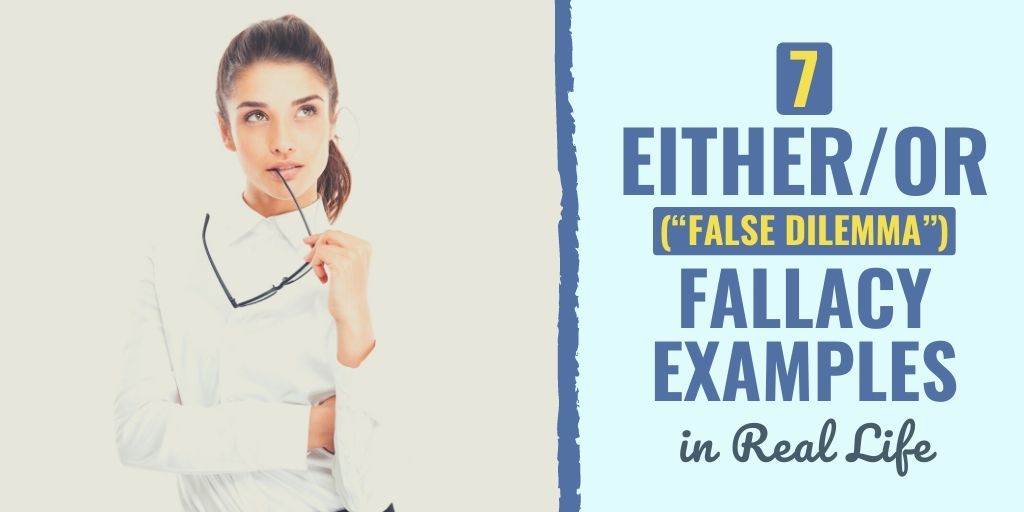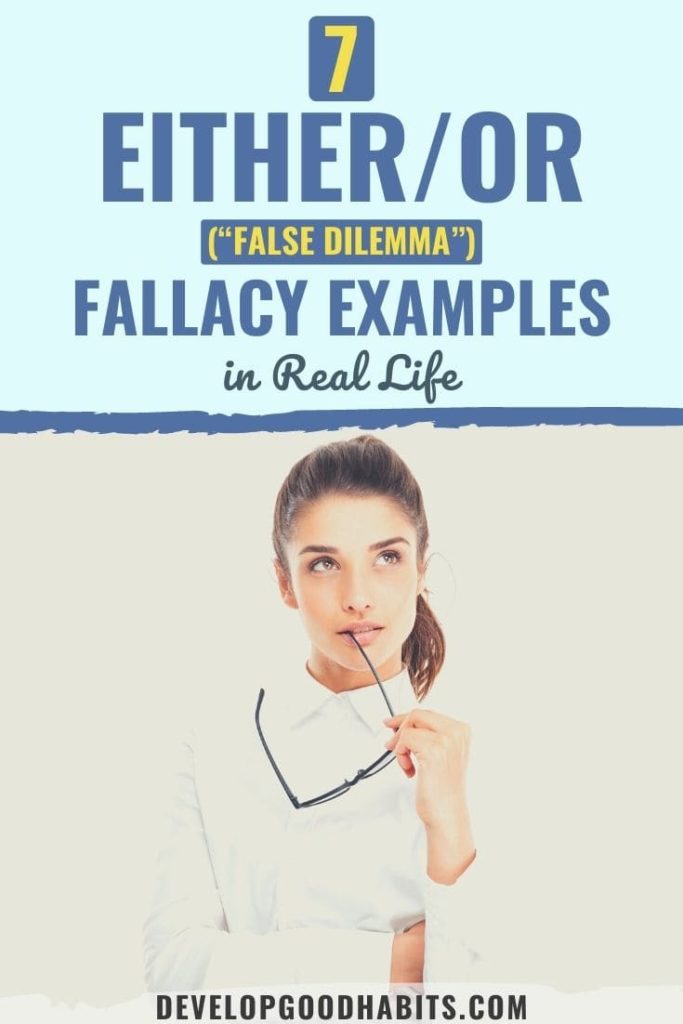There might be affiliate links on this page, which means we get a small commission of anything you buy. As an Amazon Associate we earn from qualifying purchases. Please do your own research before making any online purchase.
If you’ve ever been asked if you are a Democrat or a Republican, your answer may have fallen into neither category. In fact, according to a 2018 Pew research study, 38% of those polled claimed to be Independent in their party choice, while only 31% committed to being Democrat and 26% Republican. But the original question didn’t include this third (and most popular) option.
This is just one example of a false dilemma fallacy, in which a statement or question misleadingly claims there are only two options from which to choose, and the options are mutually exclusive. They are presented in an “either/or” format, leaving no room for a third side of the coin. However, the truth is, there are more valid options from which to choose that the speaker is failing to present.
Those who make false dilemma claims are posing a question or making a statement in absolutes–and people need to be careful when speaking in these definitive terms. An absolute refers to something that is:
Absolute words come with no exceptions. They claim something is either 100% right or 100% wrong. And, while there are some absolutes in the world, they are few and far between.
We have talked about all or nothing thinking before, which is a method of thinking that largely benefitted our ancestors who relied on their fight or flight response for their safety, but our modern society has a lot more to work with in the middle, which has turned “all or nothing” thinking into a cognitive distortion. Without considering any alternatives to two extremes, you’re not critically thinking about the situation at hand.
Today’s society is complex with subtle nuances and differences, meaning things can rarely be wrapped up in an “either A or B” format. And if you think in all or nothing terms, you’ll be limiting yourself from opening up to the spectrum on which most final determinations lie.
What Is the Either/Or Fallacy?
The either-or fallacy is a logical fallacy that simply refers to the presentation of two mutually exclusive options in a way that makes them appear to be the only options from which to choose. Those who are presented with this fallacy are left to believe that if one option is true, the other one has to be false, or if you don’t choose one, the other is inevitable by default.
You can identify this logical fallacy when you see “either/or” language being used, or when you notice there are potential options that have been left out after you’ve been given a choice of some sort.
This fallacy is also referred to as a “false dilemma” because it is used by speakers with a hidden agenda in a way to suggest you will have some type of problem if you don’t choose the “preferred” answer; when in reality, there are many outcomes that are not being mentioned that are not problematic at all.
When this logical fallacy is used on purpose, it’s typically done so with the intent of forcing a choice, when actually, both options could be true or both options could be false. This tool is effective when used in sales, politics, or to plant certain thoughts in people’s minds. Because people use this fallacious argument on purpose to influence another’s decision, it is often presented in a way where one option is clearly the superior choice, making the “right” choice (or the choice they want you to make) seem obvious.
Let’s take a look at some examples of times you may come across this logical fallacy in your everyday life to help you get used to recognizing it.
7 Either/Or (“False Dilemma”) Fallacy Examples in Real Life
1. “You could either pursue your dream job or stay where you are and be miserable for the rest of your life.”
There are a few flaws with this false dilemma. First, someone may have some barriers that are preventing them from applying for their dream job. Perhaps they need some more experience in the field or they need to get another degree in school. There are plenty of reasons why people can’t go after their desired job right now.
Second, there are a lot of jobs in between the current miserable job and the ultimate dream job. The question was posed as if the listener only has two choices; however, there are a lot of opportunities in between the two jobs that would not only be conducive to happiness, but also allow for more time to prepare to apply for a dream job.
2. “You either support praying in public schools or you’re an atheist.”
This statement is leaving out a lot of possibilities. People can certainly be religious but also recognize and respect the fact that there are a variety of religions that people practice, and one is not superior to the other. Therefore, children who practice one religion should not be forced into the rituals of another, which would mean leaving religious practices out of schools. This means that you can oppose praying in public schools, while not being an atheist.
When religion enters into the public school system, it can single out those few students who aren’t Christian–those in the minority. However, silent, individual prayer is permitted in public schools, as long as children are not partaking in government-imposed prayers being led by officials. That said, one can be an atheist and still support an individual's right to choose to pray during school on their own.
3. “You can either come with me to the party tonight or sit at home alone and be bored all night.”
Just because you’re staying home alone certainly doesn’t mean you will be bored or not do anything productive. There are a lot of options between these two extremes, including going out and doing something different aside from attending the party. But of course, staying home and engaging in a night of self-care is something we could all use on a regular basis as well.

What’s more, who’s to say that you will definitely have fun at the party? There is a chance that you could go (with the threat of possibly being bored on your radar) and end up finding the party to be boring because you don’t know anyone there.
4. “You can either drink water and be healthy or drink soda and be unhealthy.”
Of course if you took this to an extreme, you would likely be unhealthy if the only beverage you drank was soda. But, if a friend says this to you at dinner, you can be sure there’s some faulty reasoning going on. This statement isn’t addressing any other factors of your health, such as what you’re ordering for dinner. Ordering water with your large burger and fries before you go on to order three beers isn’t exactly a fast-track to perfect health.
Similarly, you may have one soda during an evening out as a treat but be well-hydrated from your normal drinking habits and maintain an active lifestyle. There are a lot of options in between the two extremes presented by the speaker in this example.
5. “You’re either part of the solution or part of the problem.”
This quote was said by Eldridge Cleaver, an author, political activist, and Black Panther leader. This problem with this statement is that it leaves no room for innocent bystanders. It gives listeners a dichotomous choice: to either take action to help resolve racial injustices or to create more work for those who are “part of the solution” by simply doing nothing.
These are two extreme points of view, and are presented as being one’s only two options from which to choose. However, one can easily not be working toward a solution to a specific problem while also doing nothing to worsen the problem either.
6. “If you want low-level employees to have higher salaries, you will have to significantly increase prices, which will push consumers away and reduce business.”
This statement creates a false dilemma by suggesting that this situation only has two possible solutions. Furthermore, the speaker makes the claim in a way that attempts to make it seem like the option of increasing employee’s salaries will come at the expense of losing business.

However, there are other ways to increase the salaries of low-level employees without raising the prices of all of the products. For example, the necessary budget could be obtained by reducing profit margins, reducing raises for upper-level employees, or doing budget cuts elsewhere.
7. “If you care about your future, you will donate to my campaign.”
This political argument is giving two options: 1) give me money 2) admit you don’t care about your future. This is clearly a ridiculous argument for several reasons, but mainly because this candidate’s opponent likely isn’t running a campaign that’s advertising to people that if they vote for the opponent, their futures will be in shambles. Furthermore, no political candidate can guarantee a positive future for any one person because there are so many factors that go into that, most of which are unrelated to an elected official.
How to Respond to a False Dilemma Fallacy
If you’re presented with an “either/or” dilemma, consider whether or not the two options presented to you are truly your only choices. Will refusing one option make the other one true by default?
If you’re the one trying to convince yourself with a false dilemma, such as: “I have to get this job or I’m never going to be hired,” try to think in a positive way by considering all of the alternative options.
If someone else is talking to you, think about the speaker’s motive and point of view. Are they trying to talk you into doing something by using a fear tactic by presenting the “alternative” option? If you do go along with what the other person is clearly presenting as the better option, who does that ultimately benefit–you, or them? If you find that it is, in fact, a false dilemma, point that out to them by stating a third option.
Final Thoughts on False Dilemma Fallacies
By oversimplifying an issue, people create false dilemmas to encourage others to think or act in a certain way. If you find yourself faced with this logical fallacy, it’s important to reject the argument and speak up about the options that the speaker is leaving out. And, if you find yourself coming up with an “either/or” fallacy when trying to get someone to do something that you want, remember this article and know that any logical person you’re talking to will see through your faulty reasoning.
Think back to these examples and consider how you may have fallen victim to the false dilemma fallacy in the past so you can avoid doing it again in the future.
Read More About Logical Fallacies
- 5 Appeal to Nature Fallacy Examples in Media and Life
- 6 Outcome Bias Examples That Can Negatively Impact Your Decisions
- 7 Self-Serving Bias Examples You See Throughout Life
- 7 Omission Bias Examples That Negatively Impact Your Life
- 6 Authority Bias Examples That Might Impact Your Decisions
- 5 Burden of Proof Fallacy Examples
- 5 Appeal to Tradition Fallacy Examples in Life
- 5 Appeal to Authority Logical Fallacy Examples
- 7 False Cause Fallacy Examples
- 7 Appeal to Ignorance Fallacy Examples
- 7 Appeal to Common Sense Logical Fallacy Examples
- 5 Post Hoc Fallacy Examples (and How to Respond to This Argument)
- Gambler’s Fallacy: 5 Examples and How to Avoid It
- 5 Appeal to Anger Fallacy Examples Throughout Life
- 7 Halo Effect Bias Examples in Your Daily Life
- 7 Poisoning the Well Examples Throughout Your Life
- 7 Survivorship Bias Examples You See in the Real World
- 7 Dunning Kruger Effect Examples in Your Life
- 5 Cui Bono Fallacy Examples to Find Out “Who Will Benefit”
- 6 Anchoring Bias Examples That Impact Your Decisions
- 7 Virtue Signaling Examples in Everyday Life
- 7 Cherry Picking Fallacy Examples for When People Ignore Evidence
- 9 Circular Reasoning Examples (or “Begging the Question”) in Everyday Life
- 9 Appeal to Emotion Logical Fallacy Examples
- 9 Appeal to Pity Fallacy (“Ad Misericordiam”) Examples in Everyday Life
- 9 Loaded Question Fallacy Examples in Life and Media
- 9 Confirmation Bias Fallacy Examples In Everyday Life
- 9 Bandwagon Fallacy Examples to Prevent Poor Decisions
- 5 Red Herring Fallacy Examples to Fight Irrelevant Information
- 5 False Equivalence Examples to Know Before Your Next Argument
- 7 Hasty Generalization Fallacy Examples & How to Respond to Them
- 6 Straw Man Fallacy Examples & How You Can Respond
- 6 False Dichotomy Examples & How to Counter Them
- 7 Slippery Slope Fallacy Examples (And How to Counter Them)
- What is the Planning Fallacy?
- How to Overcome the “Sunk Cost Fallacy” Mindset
Finally, if you want a simple process to counter the logical fallacies and cognitive biases you encounter in life, then follow this 7-step process to develop the critical thinking skills habit.

Connie Mathers is a professional editor and freelance writer. She holds a Bachelor's Degree in Marketing and a Master’s Degree in Social Work. When she is not writing, Connie is either spending time with her daughter and two dogs, running, or working at her full-time job as a social worker in Richmond, VA.


